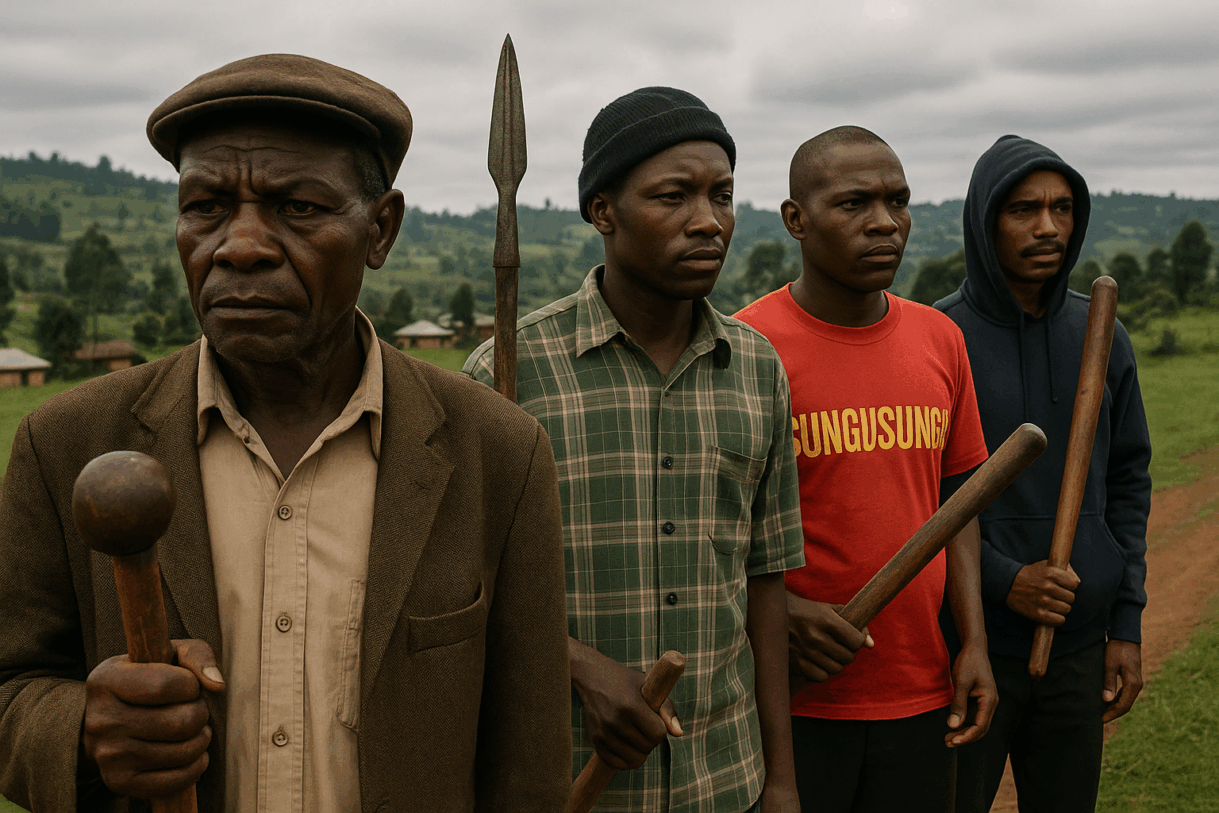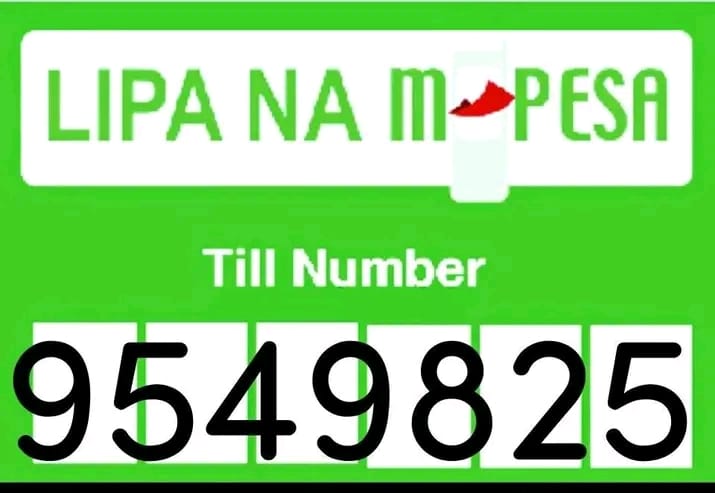
simply amazing, always for you.
In the heart of Kenya’s southwestern highlands, among the rolling hills and densely populated farmlands of Kisii County, a unique form of community justice and security has long flourished in the shadows of formal state institutions. Known locally as Sungusungu, these grassroots vigilante groups have woven themselves into the very social fabric of Gusii society. Emerging from the pressures of rural insecurity, state neglect, and cultural resilience, Sungusungu have grown into an influential—if controversial—pillar of justice and control.

Their story is one of improvisation, survival, and contradiction. They are defenders and, at times, oppressors; agents of peace and perpetrators of violence. This article explores in vivid detail how the Sungusungu came to be, how they operate, their ties to politics, their strained relationship with the Kenyan state, and the paradox they pose in a modern constitutional democracy.
Chapter 1: Origins — A Response to Fear (1970s–1980s)
1.1. The Precursor Conditions
In the late 1970s, Kenya was reeling from rural insecurity, especially in the southwest where cattle rustling was rampant. Communities in Kisii and Kuria were increasingly targeted by armed bandits. The state’s limited police force—poorly resourced and often absent in remote areas—could not respond in time, if at all.
The Gusii people, known for their deep-rooted communal traditions, found themselves under siege. The old ways—clan meetings, village watchmen, and age-grade justice systems—were collapsing under modern pressures. Something had to give.
1.2. Birth of the Sungusungu
It started quietly. Elders in the Kuria region first organized young men to patrol their villages at night. These groups were informal, but highly coordinated. They began to catch thieves red-handed, returning stolen cattle and punishing the culprits. Word spread quickly.
By the early 1980s, the Kisii community began to adopt this model. They called their version Sungusungu, a term borrowed from the Swahili word for a species of army ant—tireless, organized, relentless. The symbolism was fitting. These groups were not just security outfits; they were movements built on collective fear and righteous indignation.
Chapter 2: The Rise and Institutionalization of Vigilantism
2.1. Growing Power and Community Support
By the mid-1980s, Sungusungu groups had spread across Kisii. Their success rate in curbing livestock thefts earned them community support and donations. People voluntarily contributed money, food, and manpower. Traders and farmers alike saw them as a necessary force.
Their methods were swift and, at times, brutal. Suspects were apprehended, tried in public gatherings, and sentenced—sometimes to fines, sometimes to flogging. But the community approved. To them, justice had finally returned.
2.2. Organizational Structure
The Sungusungu were not a ragtag militia. Their internal organization mirrored quasi-military discipline. Cells were formed per village, each led by a chairperson and secretary. Patrol schedules were created, and intelligence gathering systems set up.

Meetings were frequent. Suspects were brought before community elders and Sungusungu commanders. Often, punishments were meted out instantly to serve as deterrents. With time, they developed a reputation: feared by criminals, respected by locals.
Chapter 3: Tensions with the State
3.1. Legal Ambiguity
Despite their effectiveness, the Sungusungu operated in a legal grey zone. The Kenyan Constitution gave only the state the power to arrest and punish. But rural reality had outpaced legislation. Police often looked the other way—or cooperated unofficially.
Some local chiefs began to use Sungusungu as extensions of their authority. Politicians paid them for protection. Yet, officially, they were unrecognized and unlawful.
3.2. Clashes with the Police
Over time, conflicts erupted. In 1993, a Sungusungu group in Kisii allegedly killed a suspect in custody. The police intervened, arresting several members. Protest broke out. Residents accused the state of undermining community security.
This would become a recurring pattern: brief state crackdowns followed by public outcry and the quiet return of Sungusungu patrols.
Chapter 4: The Double-Edged Sword of Justice
4.1. Rapid Justice or Mob Rule?
While the Sungusungu claimed to uphold law and order, their justice system often lacked transparency. With no access to lawyers, appeals, or state oversight, accused persons were vulnerable to wrongful punishment.
Cases of mistaken identity, personal vendettas, and coercion began to surface. Yet fear kept many from speaking out. In several cases, accused persons disappeared without a trace—either lynched or forced into exile.
4.2. Gender-Based Violence and Discrimination
Women accused of witchcraft or infidelity were especially vulnerable. In some villages, Sungusungu enforced archaic moral codes, policing everything from curfews to dress codes. Flogging and public humiliation were common. Critics called it a return to medieval justice.
Chapter 5: Politicization of Sungusungu
5.1. The 1990s Elections and Political Manipulation
During the transition to multi-party democracy in the 1990s, Sungusungu groups were enlisted by politicians to intimidate opponents and enforce “peace” during campaigns. They became private armies in all but name.
In Kisii, several politicians openly defended their use. Campaign posters featured candidates flanked by Sungusungu members. The line between protector and enforcer blurred dangerously.
5.2. The Patronage Web
Powerful leaders funded certain cells, gave them land and money, and used them to suppress dissent. Sungusungu leaders became kingmakers—deciding who could campaign in certain areas.
This entanglement weakened their grassroots credibility. Some groups devolved into extortion rings, demanding bribes and engaging in revenge attacks.
Chapter 6: Reform Efforts and Constitutional Changes
6.1. Attempts to Regulate
Under increasing pressure from human rights activists and donors, the Kenyan government tried to regulate community policing. In 2008, guidelines were issued under the Ministry of Interior, creating a framework for Nyumba Kumi (Ten Houses) and community policing committees.
Some Sungusungu groups registered under these programs, but many refused, fearing loss of autonomy. The government’s vetting process was slow and marred by politics.
6.2. 2010 Constitution and Devolution
The 2010 Constitution, hailed as a game-changer, gave counties more say in security matters. Kisii County tried to formally incorporate Sungusungu into its community policing model.
However, due to lack of funding and mistrust between national police and local leaders, the effort was only partially successful. Some groups went underground; others adapted to the new order.
Chapter 7: The Digital Age Sungusungu (2015–Present)
7.1. Technological Evolution
In recent years, some Sungusungu groups have modernized. They use smartphones, WhatsApp groups, and GPS technology to coordinate patrols. Real-time surveillance is now possible in places where radio calls once failed.
Cell leaders track stolen livestock using mobile apps. In some cases, suspects are recorded and their information disseminated to other groups instantly.
7.2. Increased Sophistication and Regional Networks
Sungusungu in Kisii are now networked with counterparts in Nyamira, Migori, and parts of Bomet. Joint patrols along county borders have become common. This regionalization has made them more effective—but also more difficult to regulate.
Chapter 8: Human Rights, Abuses, and Global Scrutiny
8.1. Rising Reports of Abuse
Organizations like Amnesty International and Kenya Human Rights Commission have flagged dozens of cases involving Sungusungu: torture, extrajudicial killings, and forced displacement. Children of accused individuals face stigma and rejection.
Despite this, convictions of Sungusungu members remain rare. Witnesses fear retaliation, and local communities often shield perpetrators.
8.2. International Pressure
Foreign embassies and donor agencies have raised concerns about Kenya’s dual justice systems. Some have withheld funding until community policing is fully brought under lawful oversight. This has pushed some Sungusungu leaders to seek legitimacy—but not all.
Chapter 9: Community Perspectives
9.1. Why Many Still Support Them
Despite the risks, many rural residents defend Sungusungu. They point to the speed of response, intimate local knowledge, and deterrent effect. For them, police arrive hours—or days—after crimes occur. Sungusungu arrive instantly.
In some villages, youth proudly join the patrols. Mothers cook for them; elders bless them. They are symbols of ownership and community strength.
9.2. The Cost of Silence
But not everyone feels safe. Journalists who investigate abuses are threatened. Activists are ostracized. Villagers whisper, but rarely report. The fear is real, and it runs deep.
Chapter 10: The Future of Sungusungu
10.1. Scenarios Ahead
There are three plausible futures for Sungusungu in Kisii:
- Reform and Integration: With proper training, oversight, and resources, Sungusungu could evolve into a regulated auxiliary force under the county and national government.
- Degeneration into Militia: If left unchecked, political manipulation and lack of accountability could turn them into full-blown criminal gangs or warlord-style militias.
- Gradual Dissolution: If trust in formal institutions grows and security improves, younger generations may abandon the movement altogether.
10.2. What Must Be Done
Reform won’t be easy, but it is essential. Steps must include:
- Legal recognition under strict human rights conditions
- Civic education for members
- Clear reporting and oversight structures
- Livelihood alternatives for idle youth
- Dialogue between state police and local groups
The Sungusungu of Kisii are a mirror—reflecting Kenya’s complex struggle between modern law and traditional justice, between fear and protection, between state power and community resilience.
They are not merely vigilantes; they are products of history, neglect, hope, and desperation. To understand them is to understand the deep undercurrents shaping rural Kenya.
What we do with that understanding—whether we allow Sungusungu to drift into darkness or help them evolve into a force for lawful good—will define not just their fate, but the very soul of community justice in Kenya.
SUGGESTED READS
- Mungiki: The Rise, Fall, and Shadows of Kenya’s Most Feared Underground Movement
- The Coffin Thief of Nairobi: The True Story of John Kibera
- The Dark Legacy of Okija Shrine: Nigeria’s Most Notorious Traditional
- How Foday Sankoh Led Sierra Leone into Chaos: The Ruthless Rise of a Rebel
- The Last Blessing: The Man Who Made It Rain From Heaven
- The Blood Oath: Rise of the Bakassi Boys

Support Our Website!
We appreciate your visit and hope you find our content valuable. If you’d like to support us further, please consider contributing through the TILL NUMBER: 9549825. Your support helps us keep delivering great content!
If you’d like to support Nabado from outside Kenya, we invite you to send your contributions through trusted third-party services such as Remitly, SendWave, or WorldRemit. These platforms are reliable and convenient for international money transfers.
Please use the following details when sending your support:
Phone Number: +254701838999
Recipient Name: Peterson Getuma Okemwa
We sincerely appreciate your generosity and support. Thank you for being part of this journey!
